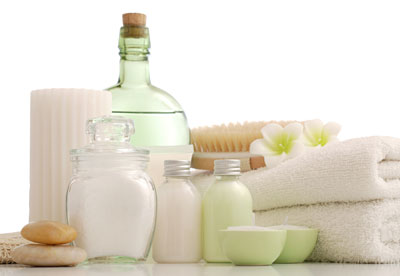The Style Glossy: Beauty Counter
Can Your Favorite Beauty Products Stop Working?
By Shelley Levitt for The Style Glossy

Every woman has had the experience: A tried-and-true beauty routine that once left your hair beautiful and shiny and your skin its radiant best suddenly seems to have stopped working. Is it time to move on to a new set of products? Here, advice from the experts.
Should You Change Your Shampoo and Conditioner?
When your once bouncy, gleaming hair starts looking flat and dull, you may wonder if it has “gotten used to” your favorite shampoo or conditioner. There are two things to keep in mind. No. 1: As hair expert John Gray, author of The World of Hair Colour and lead consultant for P&G Beauty, says, “High-quality hair products are rigorously tested to ensure that their performance does not deteriorate.” No. 2: Hair is technically dead, so it can’t develop a tolerance to a product.
That doesn’t mean that you’re imagining the changes in your hair. Residue from styling products is one common reason why hair may look and feel drab. To give your hair a clean slate, try a one-time wash with a clarifying shampoo. These shampoos contain ingredients — such as enzymes and citric acids — that bind to product deposits and whisk them away.
Seasonal changes can also make it seem like your shampoo and conditioner aren’t doing their job. In fact, these products are delivering consistent results, but it’s your hair itself that behaves differently in the high humidity of summer than it does during dry winter conditions. While you always want to choose a shampoo and conditioner that’s right for your hair type and texture, if you use a volumizng shampoo and conditioner in the summer, you may find that richer and more hydrating versions of those products work better in winter.
Coloring, highlighting, relaxing and perming all affect the fundamental properties of your hair, says Gray. If you’ve had one of these chemical processes, you may need to add deep-conditioning treatments, including masks, to keep your hair in tip-top shape. Ask your stylist for advice on how frequently to use these at-home hair care treatments.
Do You Need to Swap Your Skin Care Products?
If the feeling that your skin care regimen isn’t working any more is a familiar one, then the fault may lie with your own expectations. “Using skin care products is a lot like dieting,” says Tom Woodhouse, head esthetician at Sally Hersberger’s Face Place, a skin care clinic in New York City. “Often, you’ll see a lot of improvement over the first three months, and then when you’ve achieved the maximum benefit from the products, your skin goes into more of a maintenance mode. What you’re missing is the excitement or novelty of those early results.”
Then again, our skin is dynamic, changing in some way almost every day, says Ellen Marmur, dermatologist and author of Simple Skin Beauty: Every Woman’s Guide to a Lifetime of Healthy, Gorgeous Skin. Rather than thinking of yourself as having one static skin type, Marmur says it’s more effective to learn to read your skin and be flexible in the types of products you use. While you may have a general tendency toward dry skin or oily skin, irritation or acne, it’s important to adjust your regimen to the type of skin you’re having today. If, for example, your skin is looking greasy and starting to break out, you may want to switch temporarily to a cleanser that contains salicylic acid, which will help unclog pores.
The active ingredients that keep our skin looking its best, like peptides or retinol, work year-round. But just as cotton feels cool against your skin in July and cashmere is cozy in December, different formulations feel — and look — better as the weather changes. Consider rotating your skin care regimen to include oil-free or gel-based products in summer and richer creams and lotions in the winter.
Photo: @iStockphoto.com/manonroy
Shelley Levitt, managing editor of The
Style Glossy, is a former West Coast editor of SELF magazine and senior writer at People.




